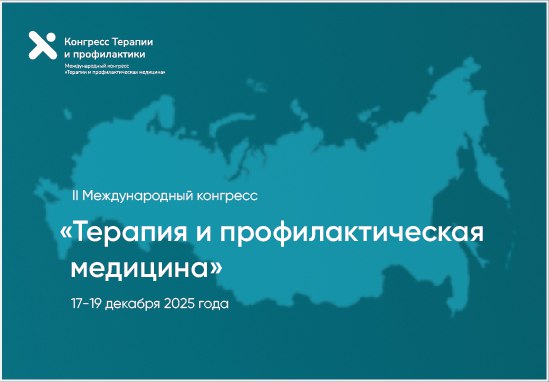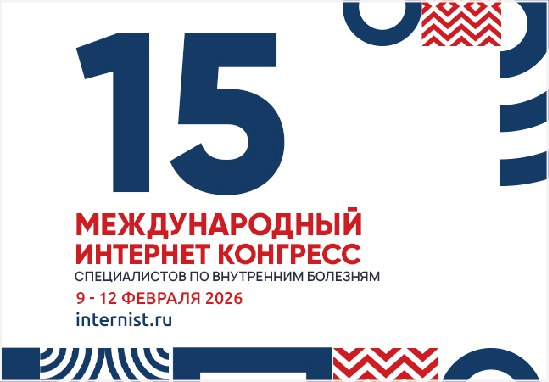Антигипертензивная эффективность монотерапии олмесартаном медоксомилом в сравнении с комбинированной терапией другими блокаторами рецепторов к ангиотензину II и гидрохлортиазидом
https://doi.org/10.15829/1728-8800-2011-5-92-98
Аннотация
Блокаторы рецепторов к ангиотензину II (БРА) применяются в США, начиная с 1995г. Эти препараты продемонстрировали антигипертензивную эффективность, по меньшей мере, не уступающую таковой для других классов антигипертензивных лекарственных средств (АГП). Согласно результатам недавно выполненных крупных рандомизированных, контролируемых, клинических исследований, БРА обладают кардио, вазо- и нефропротективными свойствами, не зависящими от их влияния на уровни системного артериального давления (АД). Эти качества позволяют рассматривать БРА как препараты первой линии, особенно у больных высокого риска. Тем не менее, так же как и для иных классов АГП, монотерапия «старыми» БРА (лозартан калия, валсартан и ирбесартан) не способна обеспечить адекватное снижение АД и достижение целевых уровней АД у значительной доли пациентов с гипертензией (АГ). Для потенцирования антигипертензивного эффекта БРА эти препараты зачастую назначают совместно с диуретиком гидрохлортиазидом (Гхт). В ряде исследований, непосредственно сравнивавших эффекты терапии отдельными БРА, были продемонстрированы различия этих препаратов по их антигипертензивному действию. В частности, в недавно выполненном, проспективном, рандомизированном исследовании терапия новым БРА олмесартаном медоксомилом напрямую сравнивалась с лечением лозартаном калием, ирбесартаном и валсартаном. Было показано, что олмесартан медоксомил вызывал достоверно более выраженное снижение диастолического АД (ДАД) (основная конечная точка), по сравнению с тремя другими БРА. Было продемонстрировано, что абсолютное снижение ДАД на фоне монотерапии олмесартаном медоксомилом сопоставимо с таковым при комбинированной терапии другими БРА и Гхт. Эти результаты могут иметь важное клиническое значение при выборе оптимальной антигипертензивной терапии (АГТ) первой линии.
Об авторе
М. ГрейтхаусСоединённые Штаты Америки
Питтсбург
Список литературы
1. Joint National Committee on Prevention, Detection, Evaluation, and Treatment of High Blood Pressure. The sixth report of the Joint National Committee on Prevention, Detection, Evaluation, and Treatment of High Blood Pressure (JNC VI). Arch Intern Med 1997;157:2413-46.
2. American Diabetes Association. Treatment of hypertension in adults with diabetes. Diabetes Care 2002;25:199-201.
3. Bakris GL, Williams M, Dworkin L, et al. Preserving renal function in adults with hypertension and diabet.es: a consensus approach. Am J Kidney Dis 2000;36:645-61.
4. Burt VL, Whelton P, Rocella EJ, et al. Prevalence ofhypertension in the US adult population: results from the Third National Health and Nutrition Examination Survey, 1988-1991 Hypertension 1995;25:305-13.
5. Hyman DJ, Pavlik VN. Characteristics of patients with uncontrolled hypertensionin the United Statest. N Engl J Med 2001;315:479-86.
6. Berlowitz DR, Ash AS, Hickey EC, et al. Inadequate management of blood pressure in a hypertensive population. N Engl J Med 1998;339: 1957-63.
7. Materson BJ, Reda DJ, Preston RA, et al., for the Department of Veterans Affairs Cooperative Study Group on Antihypertensive Agents. Response to a second single antihypertensive agent used as monotherapy for hypertension after failure of the initial drug. Arch Intern Med 1995; 155:757-62.
8. Miller NH, Hill M, Kottke T, et aI., for the Expert Panel on Compliance. The multilevel compliance challenge: recommendations for a call to action: a statement for health care professionals. Circulation 1997; 95:1085-90.
9. Caro JJ, Speckman JL, Salas M, et aI. Effectofinitial drug choice on persistence with antihypertensive therapy: the importance of actual practice data. CMAJ 1999; 160: 41-6.
10. Elliott HL Angiotensin II antagonists: efficacy, duration of action, comparison with other drugs. J Hum Hypertens 1998; 12:271-4.
11. Burnier M, Brunner HR. Comparative antihypertensive effects of angiotensin II receptor antagonists. J Am Soc Nephrol 1999;10(supp12): S278-82.
12. Ball KJ, Williams PA, Stumpe KO. Relative efficacy of an angiotensin II antagonist compared with other antihypertensive agents: olmesartan medoxomil versus antihypertensives. J Hypertens 2001; 19: 549-56.
13. Stumpe KO, Ludwig M. Antihypertensive efficacy ofolmesartan compared with oilier antihypertensive drugs J Hum Hypertens 2002;16(supp12): S24-8.
14. Puchler K, Laeis P, Stumpe KO. Blood pressure response, but not adverse event incidence, correlates with dose of angiotensin II antagonist. J Hypertens 2001;19:541-8.
15. Birkcnhager WH, de Leeuw PW. Non-peptide angiotensin type I receptor antagonists in the treatment ofhypert.ension. J Hypertens 1999;17:873-81.
16. Yusuf S, Sleight P, PogueJ. et al., for the Heart Outcomes Prevention Evaluation Study Investigators. Effectsofan angiotensin-convertingenzyme inhibitor, ramipril.ion cardiovascular events in bigh-risk patients. N Engl J Med 2000;342:145-53.
17. SOLVD Investigators. Effa.t of enalapril on mortality and the development of heart failure in asymptomatic patients with reduced left ventricular ejectionfractions. N Engl J Med 1992; 327: 685-91.
18. Brenner BM, Cooper ME, de Zeeuw D, et al., for the RENAAL Study Investigators. Effects of losartan on renal and cardiovascular outcomes in patients with type 2 diabetes and nephropathy. N Engl J Med 2001;345:861-9.
19. Lewis EJ, Hunsicker LG, Clarke WR, et.al., for the Collaborative Study Group. Renoprotective effect of the angiotensin-receptor antagonist irbesartan in patients with nephropathy due to type 2 diabetes. N Engl J Med 2001;345:851-60.
20. Cohn JN, Tognoni G. A randomized trial of the angiotensinreceptor blocker valsartan in chronic heart failure. N Engl J Med 2001;345:1667-75.
21. Dahlof B, Devereux RB, Kjeldsen SE, et al., for the UFE Study Group. Cardiovascular morbidity and mortality in the Losartan Intervention For Endpoint reduction in hypertension study (LIFE): a.randomised trial against atenolol. Lancet 2002;359:995-1003.
22. Lindholm LH, Ibsen H, Dahlof B, et al., for the LIFE Study Group. Cardiovascular morbidity and mortality in patients with diabetes in the Losartan Intervention For Endpoint reduction inhypertension study (LIFE): a randomised trial against atenolol. Lancet 2002;359: 1004-10.
23. McInnes GT. Saving lives: long term morbidity and mortality trials with selective angiotensin blocker therapy J Renin Angiotensin Aldosterone Syst 2000; I (suppl 2):17-20.
24. Oparil S, Barr E, Elkins M, et al. Efficacy, tolerability and effects on quality of life of losartan, alone or with hydrochlorothiazide, versus amlodipine, alone or with hydrochlorothiazide, in patients with essential hypertension. Clin TIIeT 1996; 18: 608-25.
25. Oparil S, Williams D, Chrysant SG, et at. Comparative efficacy of olmesartan, losartan, valsartan, and irbesartan in the control of essential hypertension. J Clin Hypertens 2001; 3:283-91.
26. Lacourciere Y, Martin K. Comparison of a fixed-dose combination of 40 mg telmisartan plus 12.5 mg hydrochlorothiazide with 40 mg telmisartan in the control of mild to moderate hypertension. Am J Ther 2002; 9: 111-7.
27. McGill JB, Reilly PA. Telmisartan plus hydrochlorothiazide versus tclmisartan or hyclrochlorothiazide monotherapy in patients with mild to moderate hypertension: a multicenter, randomized, double-blind, placebo-controlled, parallel-group trial. J Clin Ther 2001;23:833-50.
28. White WB, Anwar YA, Mansoor GA, et aI. Evaluation ofthe 24hour blood pressure effects ofeprosartan in patients with systemichypenension. Am J Hypertens 2001; 14: 1248-55.
29. Conlin PR, Spence JD, Williams B. et al. Angiotensin II antagonists for hypertension: are there differences in efficacy? Am J Hypertens 2000; 13: 418-26.
30. Bakris G, Gradman A, Reif M, et al. Antihypertensive efficacy of candesartan in comparison to losartan: the CLAIM study. J Clin Hypertens 2001; 3: 16-21.
31. Kassler-Taub K. Littlejohn T, Elliott W, et al., for the Irbesartan/Losartan Study Investigators. Comparative efficacy oftwo angiotensin ITreceptor antagonists, irbesartan and losartan, in mild-to-moderate hypertension Am J Hypertens 1998; 11: 445-53.
32. Mancia C. Clinical differences among angiotensin II antagonists. Blood Press 2001; suppl 2: 19-24.
33. Neutel JM. Clinical studies of C.5-866, the newest angiotensin II receptor antagonist. Am J Cardiol 2001;87(suppl):37C-43.
34. Ball K A multi-centre, double-blind, efficacy tolerability and safety study of the oral angiotensin IT-antagonist olmesartan medoxomil versus losartan in patients with mild to moderate essential hypertension. J Hypertens 2001; 19(suppl 2): SI55.
35. Conlin PR Angiotensin II antagonists in the treatment of hypertension: more similarities than differences. J Clitt Hypertens 2000; 2: 253-7.
Рецензия
Для цитирования:
Грейтхаус М. Антигипертензивная эффективность монотерапии олмесартаном медоксомилом в сравнении с комбинированной терапией другими блокаторами рецепторов к ангиотензину II и гидрохлортиазидом. Кардиоваскулярная терапия и профилактика. 2011;10(5):92-98. https://doi.org/10.15829/1728-8800-2011-5-92-98
For citation:
Greathouse M. A review of olmesartan medoxomil monotherapy: antihypertensive efficacy similar to that of other angiotensin II receptor blocker/hydrochlorothiazide combinations? Cardiovascular Therapy and Prevention. 2011;10(5):92-98. (In Russ.) https://doi.org/10.15829/1728-8800-2011-5-92-98
























































